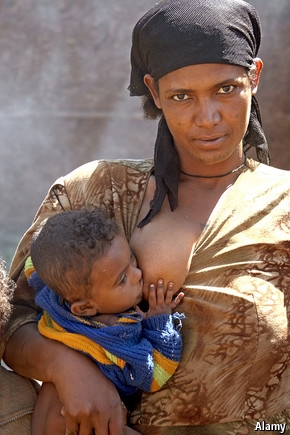(单词翻译:单击)
HIV and mothers’ milk
艾滋病病毒与母乳
As luck would have it
真不巧
One of the proteins in milk protects infants against HIV infection
母乳中的一种蛋白质可保护婴儿免受艾滋病病毒感染
Oct 26th 2013 |From the print edition

BAD though it has been, the AIDS epidemic would have been a great deal worse but for a strange and unexplained quirk. Infected mothers, it was feared, would transmit HIV, the AIDS-causing virus, to their children when suckling them. Mothers’ milk carries the virus, and suckling may last two years—which is plenty of time for transmission to happen. And indeed it does, but not nearly as often as was originally suspected. Less than 10% of infants suckled by untreated infected mothers (those not on antiretroviral drugs, which suppress the virus’s reproduction) pick up HIV.
尽管情况很糟糕了,但是由于一种奇怪的无法解释的现象,艾滋病的流行程度没有更糟。很多人担心受感染的母亲会在哺乳时将艾滋病病毒传播给自己的孩子。母乳携带有艾滋病病毒,哺乳期可能达到两年,这给传染提供了足够长的时间。而事实上传染也发生了,但是跟最初所怀疑的有出入。只有不到10%的婴儿会从未接受治疗的母亲那里感染艾滋病(未接受治疗是指没有使用抑制病毒繁殖的抗逆转录药物)。
Why that should be has remained mysterious. But Genevieve Fouda of Duke University, in North Carolina, and her colleagues think they have the answer. If they are right, many children have been spared AIDS by a fluke—but a fluke that could be used to develop a new weapon to attack it.
上述问题一直是未解之谜。但是北卡罗来纳州杜克大学的吉纳维夫·富达和她的同事认为他们找到了答案。如果他们是正确的,这意味着许多儿童侥幸逃过艾滋病,这种侥幸能用来开发一种对抗艾滋病的新武器。
Clearly, something in milk disables HIV. Previous experiments had identified proteins that do this to a certain extent, but nowhere near enough to explain all the data. Those earlier searches must therefore have missed something crucial. Dr Fouda, as she describes in the Proceedings of the National Academy of Sciences, set out to find what it was.
很明显,母乳中的某种物质会阻止艾滋病病毒。先前的实验确定了蛋白质能在一定程度上阻止艾滋病病毒,但是不足以解释所有的数据。那么,先前的研究肯定错过了一些关键的东西。富达博士在美国国家科学院院刊上表示她试图发现错过的东西。
Milk is a complex mixture of chemicals, so her problem was how to isolate one of them without knowing in advance which was responsible. That meant running raw milk through a series of processes, each of which divided it into smaller and smaller fractions, and testing each fraction for its HIV-neutralising quality on the way. That quality, it turns out, is concentrated in a single protein called tenascin-C. Further experiments showed that this protein disables HIV by locking onto a protein on the virus’s surface, and that it is as effective at doing so as antibodies generated by the immune system for that specific purpose.
牛奶是一种复杂的混合物,因此问题在于在事先不知道的情况下如何找出它们中起作用的那种物质。这意味着将生牛奶通过一系列过程,每次将生牛奶分成更小的成分,测试每个成分对艾滋病病毒的作用。使艾滋病病毒无效的特性属于一种被称作黏蛋白C的蛋白质。更进一步的实验表明这种蛋白质通过附着在病毒表面的一种蛋白质上而阻止艾滋病病毒,效果跟免疫系统产生的抗体一样。
This was a surprise, because tenascin-C is not an antibody, nor had it been suspected of having any antiviral function. Its known jobs are to help the development of the fetal brain and to assist in wound healing. That it is also the right shape to attach itself to HIV’s envelope protein seems a complete coincidence—which, indeed, it must be because AIDS is such a recent disease that evolution could not have had time to throw up a novel (and also ubiquitous) anti-HIV protein of this sort.
这很意外,因为黏蛋白C既不是抗体,也没有任何抗病毒功能。已知的功能是帮助胎儿大脑的发育和伤口愈合。黏蛋白C与艾滋病病毒的信使蛋白相吻合也纯属巧合,肯定是这样的,因为艾滋病是最近才出现的疾病,进化没有足够的时间产生这种新型(无处不在的)抗艾滋病蛋白。
Whether tenascin-C, or something derived from it, can be deployed against HIV by doctors, rather than just by nature, remains to be seen. As far as possible, infected mothers are now given antiretroviral drugs—both for their own health and for the health of their suckling infants—so Dr Fouda’s discovery will probably not affect them directly.
黏蛋白C,或者它的衍生物,排除其原始性质,能否被医生用于对抗艾滋病仍需要进一步研究。最可能的是,受感染的母亲们现在接受抗逆转录药物,为了她们自己以及孩子的健康,因此富达博士的发现可能不会对她们产生直接影响。
For the wider campaign against AIDS, however, it could be of great importance. The generals running that campaign are now shifting their approach from defence to attack, and are talking of ways to bring about an AIDS-free world. For them, a natural human protein that neutralises the virus will be interesting indeed.
然而,对防治艾滋病运动来说,这个发现可能至关重要。运动的领导者们现在改变方法,从防守变为进攻,正在讨论消灭艾滋病。对他们来说,一种人类天生具有的对抗艾滋病病毒的蛋白质真的很有趣。


